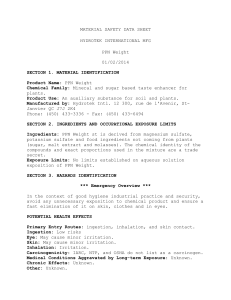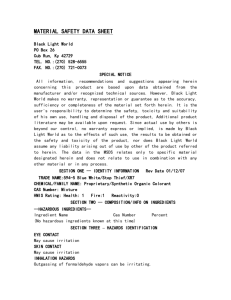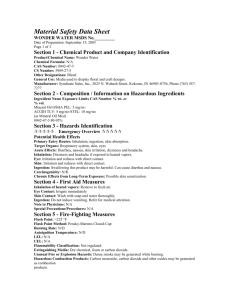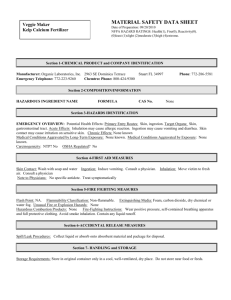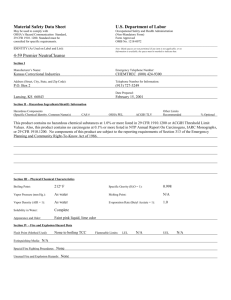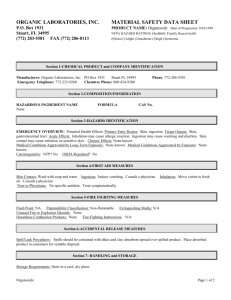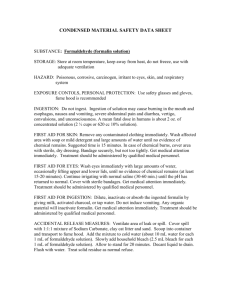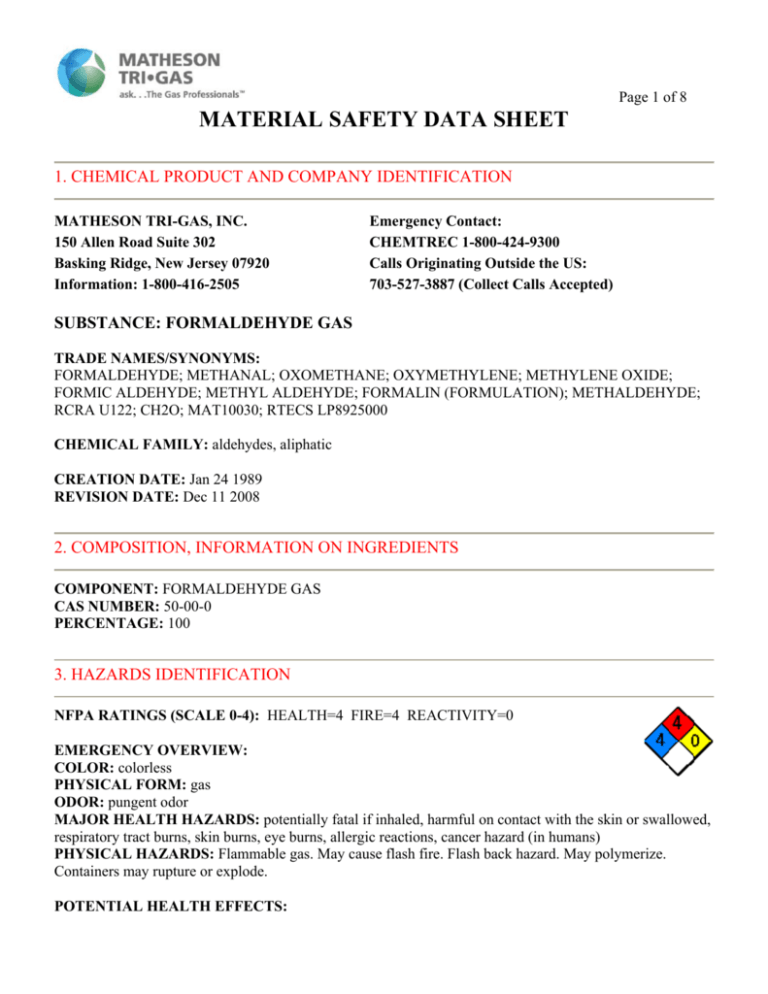
Page 1 of 8
MATERIAL SAFETY DATA SHEET
1. CHEMICAL PRODUCT AND COMPANY IDENTIFICATION
MATHESON TRI-GAS, INC.
150 Allen Road Suite 302
Basking Ridge, New Jersey 07920
Information: 1-800-416-2505
Emergency Contact:
CHEMTREC 1-800-424-9300
Calls Originating Outside the US:
703-527-3887 (Collect Calls Accepted)
SUBSTANCE: FORMALDEHYDE GAS
TRADE NAMES/SYNONYMS:
FORMALDEHYDE; METHANAL; OXOMETHANE; OXYMETHYLENE; METHYLENE OXIDE;
FORMIC ALDEHYDE; METHYL ALDEHYDE; FORMALIN (FORMULATION); METHALDEHYDE;
RCRA U122; CH2O; MAT10030; RTECS LP8925000
CHEMICAL FAMILY: aldehydes, aliphatic
CREATION DATE: Jan 24 1989
REVISION DATE: Dec 11 2008
2. COMPOSITION, INFORMATION ON INGREDIENTS
COMPONENT: FORMALDEHYDE GAS
CAS NUMBER: 50-00-0
PERCENTAGE: 100
3. HAZARDS IDENTIFICATION
NFPA RATINGS (SCALE 0-4): HEALTH=4 FIRE=4 REACTIVITY=0
EMERGENCY OVERVIEW:
COLOR: colorless
PHYSICAL FORM: gas
ODOR: pungent odor
MAJOR HEALTH HAZARDS: potentially fatal if inhaled, harmful on contact with the skin or swallowed,
respiratory tract burns, skin burns, eye burns, allergic reactions, cancer hazard (in humans)
PHYSICAL HAZARDS: Flammable gas. May cause flash fire. Flash back hazard. May polymerize.
Containers may rupture or explode.
POTENTIAL HEALTH EFFECTS:
Page 2 of 8
INHALATION:
SHORT TERM EXPOSURE: allergic reactions, burns, death
LONG TERM EXPOSURE: burns, cancer
SKIN CONTACT:
SHORT TERM EXPOSURE: allergic reactions, burns
LONG TERM EXPOSURE: burns
EYE CONTACT:
SHORT TERM EXPOSURE: burns
LONG TERM EXPOSURE: burns
INGESTION:
SHORT TERM EXPOSURE: ingestion of a gas is unlikely
LONG TERM EXPOSURE: ingestion of a gas is unlikely
4. FIRST AID MEASURES
INHALATION: If adverse effects occur, remove to uncontaminated area. Give artificial respiration if not
breathing. If breathing is difficult, oxygen should be administered by qualified personnel. Get immediate
medical attention.
SKIN CONTACT: Wash skin with soap and water for at least 15 minutes while removing contaminated
clothing and shoes. Get immediate medical attention. Thoroughly clean and dry contaminated clothing
before reuse. Destroy contaminated shoes.
EYE CONTACT: Immediately flush eyes with plenty of water for at least 15 minutes. Then get immediate
medical attention.
INGESTION: If a large amount is swallowed, get medical attention.
NOTE TO PHYSICIAN: For inhalation, consider oxygen.
5. FIRE FIGHTING MEASURES
FIRE AND EXPLOSION HAZARDS: Severe fire hazard. Vapor/air mixtures are explosive. The vapor is
heavier than air. Vapors or gases may ignite at distant ignition sources and flash back. Containers may
rupture or explode if exposed to heat.
EXTINGUISHING MEDIA: carbon dioxide, regular dry chemical
Large fires: Use regular foam or flood with fine water spray.
FIRE FIGHTING: Move container from fire area if it can be done without risk. Cool containers with water
spray until well after the fire is out. Stay away from the ends of tanks. For fires in cargo or storage area: Cool
containers with water from unmanned hose holder or monitor nozzles until well after fire is out. If this is
impossible then take the following precautions: Keep unnecessary people away, isolate hazard area and deny
Page 3 of 8
entry. Let the fire burn. Withdraw immediately in case of rising sound from venting safety device or any
discoloration of tanks due to fire. For tank, rail car or tank truck: Evacuation radius: 800 meters (1/2 mile).
Do not attempt to extinguish fire unless flow of material can be stopped first. Flood with fine water spray.
Cool containers with water. Apply water from a protected location or from a safe distance. Avoid inhalation
of material or combustion by-products. Stay upwind and keep out of low areas. Stop flow of gas.
LOWER FLAMMABLE LIMIT: 7.0%
UPPER FLAMMABLE LIMIT: 73%
AUTOIGNITION: 795 F (424 C)
6. ACCIDENTAL RELEASE MEASURES
AIR RELEASE:
Reduce vapors with water spray. Stay upwind and keep out of low areas.
WATER RELEASE:
Subject to California Safe Drinking Water and Toxic Enforcement Act of 1986 (Proposition 65). Keep out of
water supplies and sewers.
OCCUPATIONAL RELEASE:
Avoid heat, flames, sparks and other sources of ignition. Stop leak if possible without personal risk. Reduce
vapors with water spray. Keep unnecessary people away, isolate hazard area and deny entry. Remove
sources of ignition. Ventilate closed spaces before entering. Notify Local Emergency Planning Committee
and State Emergency Response Commission for release greater than or equal to RQ (U.S. SARA Section
304). If release occurs in the U.S. and is reportable under CERCLA Section 103, notify the National
Response Center at (800)424-8802 (USA) or (202)426-2675 (USA).
7. HANDLING AND STORAGE
STORAGE: Store and handle in accordance with all current regulations and standards. Protect from
physical damage. Use diking sufficient to contain total contents plus 10%. Subject to storage regulations:
U.S. OSHA 29 CFR 1910.101. Notify State Emergency Response Commission for storage or use at amounts
greater than or equal to the TPQ (U.S. EPA SARA Section 302). SARA Section 303 requires facilities
storing a material with a TPQ to participate in local emergency response planning (U.S. EPA 40 CFR 355
Part B). Keep separated from incompatible substances.
HANDLING: Subject to handling regulations: U.S. OSHA 29 CFR 1910.119.
8. EXPOSURE CONTROLS, PERSONAL PROTECTION
EXPOSURE LIMITS:
FORMALDEHYDE GAS:
FORMALDEHYDE:
Page 4 of 8
0.75 ppm OSHA TWA
2 ppm OSHA STEL 15 minute(s)
0.5 ppm OSHA action level
0.3 ppm ACGIH ceiling (sensitizer)
0.016 ppm NIOSH recommended TWA 10 hour(s)
0.1 ppm NIOSH recommended ceiling 15 minute(s)
VENTILATION: Ventilation equipment should be explosion-resistant if explosive concentrations of
material are present. Provide local exhaust or process enclosure ventilation system. Ensure compliance with
applicable exposure limits.
EYE PROTECTION: Wear splash resistant safety goggles with a faceshield. Provide an emergency eye
wash fountain and quick drench shower in the immediate work area.
CLOTHING: Wear appropriate chemical resistant clothing.
GLOVES: Wear appropriate chemical resistant gloves. OSHA REGULATED SUBSTANCES: U.S. OSHA
29 CFR 1910.1048.
RESPIRATOR: The following respirators and maximum use concentrations are drawn from NIOSH and/or
OSHA.
OSHA Standard:
Respirator selection should comply with 29 CFR 1910.134, 29 CFR 1910.1048, and the final rule published
in the Federal Register on August 24, 2006.
NIOSH Recommendations:
At any detectable concentration Any self-contained breathing apparatus that has a full facepiece and is operated in a pressure-demand or
other positive-pressure mode.
Any supplied-air respirator with a full facepiece that is operated in a pressure-demand or other positivepressure mode in combination with an auxiliary self-contained breathing apparatus operated in pressuredemand or other positive-pressure mode.
Escape Any air-purifying full-facepiece respirator (gas mask) with a chin-style, front-mounted or back-mounted
canister providing protection against the compound of concern.
Any appropriate escape-type, self-contained breathing apparatus.
9. PHYSICAL AND CHEMICAL PROPERTIES
PHYSICAL STATE: gas
COLOR: colorless
ODOR: pungent odor
MOLECULAR WEIGHT: 30.03
MOLECULAR FORMULA: H-C-H-O
BOILING POINT: -6 F (-21 C)
FREEZING POINT: -134 F (-92 C)
VAPOR PRESSURE: 400 mmHg @ -33 C
Page 5 of 8
VAPOR DENSITY (air=1): 1.07
SPECIFIC GRAVITY (water=1): 0.815 @ -20 C
WATER SOLUBILITY: 55%
PH: Not applicable
VOLATILITY: Not applicable
ODOR THRESHOLD: 1 ppm
EVAPORATION RATE: Not applicable
COEFFICIENT OF WATER/OIL DISTRIBUTION: Not applicable
SOLVENT SOLUBILITY:
Soluble: alcohol, ether, acetone, benzene, chloroform
10. STABILITY AND REACTIVITY
REACTIVITY: Stable at normal temperatures and pressure.
CONDITIONS TO AVOID: Avoid heat, flames, sparks and other sources of ignition. Minimize contact
with material. Containers may rupture or explode if exposed to heat.
INCOMPATIBILITIES: acids, bases, reducing agents, metals, metal salts, halogens, combustible materials,
peroxides, oxidizing materials
HAZARDOUS DECOMPOSITION:
Thermal decomposition products: oxides of carbon
POLYMERIZATION: May polymerize.
11. TOXICOLOGICAL INFORMATION
FORMALDEHYDE GAS:
IRRITATION DATA: 150 ug/3 day(s)-intermittent skin-human mild; 4 ppm/5 minute(s) eyes-human; 1
ppm/6 minute(s) rinsed eyes-human mild; 2 mg/24 hour(s) skin-rabbit severe; 540 mg open skin-rabbit mild;
50 mg/24 hour(s) skin-rabbit moderate; 750 ug/24 hour(s) eyes-rabbit severe; 750 ug eyes-rabbit severe; 10
mg eyes-rabbit severe; 37 percent eyes-rabbit severe; 2 percent/48 hour(s) skin-human
TOXICITY DATA: 203 mg/m3 inhalation-rat LC50; 270 ul/kg skin-rabbit LD50; 100 mg/kg oral-rat LD50
CARCINOGEN STATUS: OSHA: Carcinogen; NTP: Anticipated Human Carcinogen; IARC: Human
Sufficient Evidence, Animal Sufficient Evidence, Group 1; ACGIH: A2 -Suspected Human Carcinogen; EC:
Category 3
LOCAL EFFECTS:
Corrosive: inhalation, skin, eye, ingestion
ACUTE TOXICITY LEVEL:
Highly Toxic: inhalation
Toxic: dermal absorption, ingestion
TARGET ORGANS: immune system (sensitizer)
MEDICAL CONDITIONS AGGRAVATED BY EXPOSURE: respiratory disorders, skin disorders and
Page 6 of 8
allergies
TUMORIGENIC DATA: Available.
MUTAGENIC DATA: Available.
REPRODUCTIVE EFFECTS DATA: Available.
12. ECOLOGICAL INFORMATION
ECOTOXICITY DATA:
FISH TOXICITY: 4960 ug/L 96 hour(s) LC50 (Mortality) Striped bass (Morone saxatilis)
INVERTEBRATE TOXICITY: 14000 ug/L 48 hour(s) EC50 (Physiological) Water flea (Daphnia magna)
ALGAL TOXICITY: 4500 ug/L 48 hour(s) (Population Growth) Cryptomonad (Chilomonas paramecium)
FATE AND TRANSPORT:
KOW: 151.36 (log = 2.18) (estimated from water solubility)
KOC: 481.95 (log = 2.69) (estimated from water solubility)
HENRY'S LAW CONSTANT: 2.9 E -5 atm-m3/mol
BIOCONCENTRATION: 0.35 (estimated from water solubility)
AQUATIC PROCESSES: 1.4256148 hours (River Model: 1 m deep, 1 m/s flow, 3 m/s wind)
ENVIRONMENTAL SUMMARY: Relatively non-persistent in the environment. Leaches through the soil
or the sediment at a moderate rate. Accumulates very little in the bodies of living organisms. Moderately
volatile from water.
13. DISPOSAL CONSIDERATIONS
Dispose in accordance with all applicable regulations. Subject to disposal regulations: U.S. EPA 40 CFR 262.
Hazardous Waste Number(s): U122.
14. TRANSPORT INFORMATION
INTERNATIONAL U.S. DOT 49 CFR 172.101:
PROPER SHIPPING NAME: Compressed gas, toxic, flammable, corrosive, n.o.s. (FORMALDEHYDE
GAS)
ID NUMBER: UN3305
HAZARD CLASS OR DIVISION: 2.3
LABELING REQUIREMENTS: 2.3; 2.1; 8
QUANTITY LIMITATIONS:
Page 7 of 8
PASSENGER AIRCRAFT OR RAILCAR: Forbidden
CARGO AIRCRAFT ONLY: Forbidden
CANADIAN TRANSPORTATION OF DANGEROUS GOODS:
SHIPPING NAME: Compressed gas, toxic, flammable, corrosive, n.o.s. (FORMALDEHYDE GAS)
UN NUMBER: UN3305
CLASS: 2.3; 2.1; 8
15. REGULATORY INFORMATION
U.S. REGULATIONS:
CERCLA SECTIONS 102a/103 HAZARDOUS SUBSTANCES (40 CFR 302.4):
Formaldehyde: 100 LBS RQ
SARA TITLE III SECTION 302 EXTREMELY HAZARDOUS SUBSTANCES (40 CFR 355 Subpart
B):
Formaldehyde: 500 LBS TPQ
SARA TITLE III SECTION 304 EXTREMELY HAZARDOUS SUBSTANCES (40 CFR 355 Subpart
C):
Formaldehyde: 100 LBS RQ
SARA TITLE III SARA SECTIONS 311/312 HAZARDOUS CATEGORIES (40 CFR 370 Subparts B
and C):
ACUTE: Yes
CHRONIC: Yes
FIRE: Yes
REACTIVE: No
SUDDEN RELEASE: Yes
SARA TITLE III SECTION 313 (40 CFR 372.65):
Formaldehyde
OSHA PROCESS SAFETY (29 CFR 1910.119):
Formaldehyde: 1000 LBS TQ
STATE REGULATIONS:
California Proposition 65:
Known to the state of California to cause the following:
Formaldehyde
Cancer (Jan 01, 1988)
CANADIAN REGULATIONS:
WHMIS CLASSIFICATION: Not determined.
NATIONAL INVENTORY STATUS:
Page 8 of 8
U.S. INVENTORY (TSCA): Listed on inventory.
TSCA 12(b) EXPORT NOTIFICATION: Not listed.
CANADA INVENTORY (DSL/NDSL): Not determined.
16. OTHER INFORMATION
“RTECS®” is a United States trademark owned and licensed under authority of the U.S. Government, by
and through Symyx Software, Inc. Portions ©Copyright 2001, U.S. Government. All rights reserved.
©Copyright 1984-2009 ChemADVISOR, Inc. All rights reserved.
MATHESON TRI-GAS, INC. MAKES NO EXPRESS OR IMPLIED WARRANTIES,
GUARANTEES OR REPRESENTATIONS REGARDING THE PRODUCT OR THE
INFORMATION HEREIN, INCLUDING BUT NOT LIMITED TO ANY IMPLIED WARRANTY
OF MERCHANTABILITY OR FITNESS FOR USE. MATHESON TRI-GAS, INC. SHALL NOT BE
LIABLE FOR ANY PERSONAL INJURY, PROPERTY OR OTHER DAMAGES OF ANY NATURE,
WHETHER COMPENSATORY, CONSEQUENTIAL, EXEMPLARY, OR OTHERWISE,
RESULTING FROM ANY PUBLICATION, USE OR RELIANCE UPON THE INFORMATION
HEREIN.


